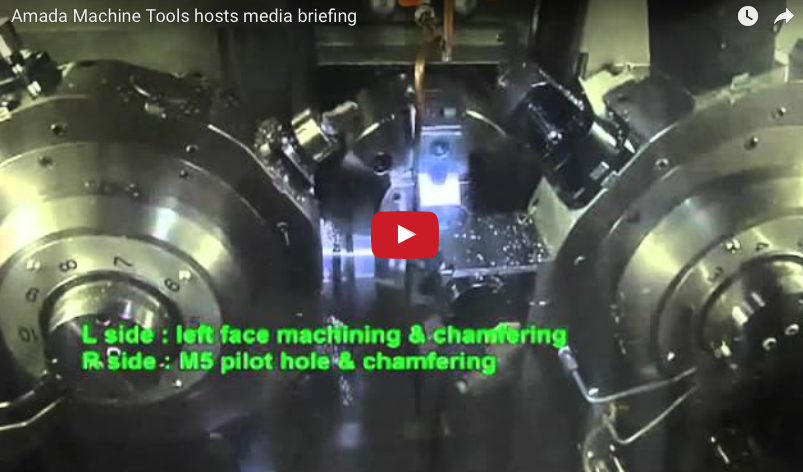As part of Amada Machine Tools America Inc.’s introduction of a multitask machine and a profile grinder to the North American market, the machine tool builder hosted a media briefing event Feb. 29 at its 40,000-sq.-ft. Technical Center in Schaumburg, Ill.
George Kowalewski, national sales manager, provided a presentation about the S-10 mill/turn machine, which has one spindle and two turrets that each have eight or 12 stations. The twin turrets enable simultaneous machining using live tools on each turret. The machine also has a subspindle for machining a part on six sides. A reversing vise accessory is another method for working both ends of a part in one loading. According to the company, the machine’s modular design enables users to tailor the S-10 for specific jobs. The machine is suitable for gantry loading, bar feeding and manual loading of parts.


Amada Machine Tools demonstrated its new S-10 modular multitask machine during a recent press briefing at its Technical Center in Schaumburg, Ill. Click here to view video footage courtesy Amada Machine Tools America Inc.

As part of Amada Machine Tools America Inc.’s introduction of a multitask machine and a profile grinder to the North American market, the machine tool builder hosted a media briefing event Feb. 29 at its 40,000-sq.-ft. Technical Center in Schaumburg, Ill.
George Kowalewski, national sales manager, provided a presentation about the S-10 mill/turn machine, which has one spindle and two turrets that each have eight or 12 stations. The twin turrets enable simultaneous machining using live tools on each turret. The machine also has a subspindle for machining a part on six sides. A reversing vise accessory is another method for working both ends of a part in one loading. According to the company, the machine’s modular design enables users to tailor the S-10 for specific jobs. The machine is suitable for gantry loading, bar feeding and manual loading of parts.
Amada is targeting the S-10 toward hydraulic equipment and automotive OEMs and their Tier 1 suppliers, as well as parts manufacturers serving the aerospace, defense and medical industries, Kowalewski noted. General parts manufacturers are also on the company’s radar. “We don’t discount that market,” he said.
Bob Hamada, grinding products manager, detailed the features of DV-7M CNC profile grinder for producing cutting tools, cylindrical crush rolls and punches and dies. The 7-axis machine swivels the grinding wheel during grinding to reduce wheel wear, Hamada noted. “Swivel technology is the heart of the machine.”
Amada reports that the DV-7M’s vision system eliminates cumbersome charts, compares downloaded CAD files with the actual part profile, sets the swiveling wheel pivot point to the workpiece edge and then enables in-machine digital inspection of all components.
Hamada emphasized that the grinder is ideal for producing complex geometries, such as those on form tools, and can grind any relief and rake angle, including logarithmic relief for hobs. Those angles are programmable for consistent accuracy and smooth blends, according to the company.
Related Glossary Terms
- computer numerical control ( CNC)
computer numerical control ( CNC)
Microprocessor-based controller dedicated to a machine tool that permits the creation or modification of parts. Programmed numerical control activates the machine’s servos and spindle drives and controls the various machining operations. See DNC, direct numerical control; NC, numerical control.
- computer-aided design ( CAD)
computer-aided design ( CAD)
Product-design functions performed with the help of computers and special software.
- grinding
grinding
Machining operation in which material is removed from the workpiece by a powered abrasive wheel, stone, belt, paste, sheet, compound, slurry, etc. Takes various forms: surface grinding (creates flat and/or squared surfaces); cylindrical grinding (for external cylindrical and tapered shapes, fillets, undercuts, etc.); centerless grinding; chamfering; thread and form grinding; tool and cutter grinding; offhand grinding; lapping and polishing (grinding with extremely fine grits to create ultrasmooth surfaces); honing; and disc grinding.
- grinding wheel
grinding wheel
Wheel formed from abrasive material mixed in a suitable matrix. Takes a variety of shapes but falls into two basic categories: one that cuts on its periphery, as in reciprocating grinding, and one that cuts on its side or face, as in tool and cutter grinding.
- modular design ( modular construction)
modular design ( modular construction)
Manufacturing of a product in subassemblies that permits fast and simple replacement of defective assemblies and tailoring of the product for different purposes. See interchangeable parts.
- rake
rake
Angle of inclination between the face of the cutting tool and the workpiece. If the face of the tool lies in a plane through the axis of the workpiece, the tool is said to have a neutral, or zero, rake. If the inclination of the tool face makes the cutting edge more acute than when the rake angle is zero, the rake is positive. If the inclination of the tool face makes the cutting edge less acute or more blunt than when the rake angle is zero, the rake is negative.
- relief
relief
Space provided behind the cutting edges to prevent rubbing. Sometimes called primary relief. Secondary relief provides additional space behind primary relief. Relief on end teeth is axial relief; relief on side teeth is peripheral relief.
- vision system
vision system
System in which information is extracted from visual sensors to allow machines to react to changes in the manufacturing process.







